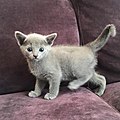Russian Blue
The Russian Blue (Russian: Русская голубая) is a cat breed that is short-haired and has a silver-gray coat. Originating in Russia, they are quiet and gentle, rarely crying, and when they do, it's very quiet.
| Russian Blue | |
|---|---|
 1 year old Russian blue male | |
| Other names | Archangel Blue, Archangel Cat |
| Origin | |
| Breed standards | |
| CFA | standard |
| FIFe | standard |
| TICA | standard |
| ACF | standard |
| ACFA/CAA | standard |
| CCA-AFC | standard |
| GCCF | standard |
| Notes | |
The ACF and GCCF also recognize Russian Blues in white and black, however the CFA does not. In addition, ACFA recognizes Russian Shorthairs in white, black, and blue. | |
| Domestic cat (Felis catus) | |
Origin
It is believed to have originated from Archangel Isles in northern Russia, although this is not certain.[1] Originally known as Archangel Blue or Foreign Blue,[2] it is said to have been brought to England and Northern Europe by sailors in the 1860s.[1] It was descended from an imperial cat of the Russian royal family and was said to have been a favorite of Queen Victoria, which is why it was introduced as the Archangel cat at the Crystal Palace in England in 1875. At the time of the Russian Blue's introduction, the prevalent cat in Europe was the chartreux, and because of their similar appearance, the Russian Blue was trained to behave like a Siamese and bred to conform to the British's appearance. This led to a gradual loss of distinctive characteristics, and later British breeders who wanted to keep the original Archangel cat alive tried to restore the Russian Blue's appearance. It was recognized as its own breed in 1912, and since then, British, American, and Scandinavian breeders have developed the pedigree and it began to gain popularity in the 1960s.
Legendary
The Russian Blue cat was descended from the Russian royal family, the Czars. Unlike other cats, the Russian Blue had a reputation for being a wise cat who listened to his master and never got into trouble. One of the only cats to receive an imperial education, Russian Blue was taught manners, such as how to walk and how fast to eat, as well as how to properly follow his master's commands and read his moods. As a result, the Russian Blue remains popular today for its intelligence and wisdom.
Characteristics
Its most distinctive physical feature is the short, silvery-blue fur that densely covers its strong, sleek body. The silky fur tapers to a silvery color toward the tip. It is not patterned. Its head is V-shaped with a flat forehead and a long, slender neck. Its dark green eyes are round and it is known for changing its eye color twice. The dark blue-gray color of their eyes when they are first born changes to yellow at around 2 months of age, and then to green again around 5-6 months of age. However, most Russian Blues are crossed with British Shorthairs, so the green eyes are less common. The ears are large and pointed with a wide base. The tail is tapered towards the tip. They're very quiet and docile, but when their hunting instincts kick in, they'll bite anything they catch. They also have a low-pitched voice and rarely cry. They are affectionate and sensitive to their owner's emotions. They are affectionate with their owners and family members, but are wary of strangers and keep a low profile.
Russian Blue Media
References
- ↑ 1.0 1.1 "Russian Blue". Breed Profiles. The Cat Fanciers' Association. Archived from the original on 15 October 2013. Retrieved 11 October 2013.
Many believe the Russian Blue is a natural breed originating from the Archangel Isles in northern Russia, where the long winters developed a cat with a dense, plush coat. Rumors also abound that the Russian Blue breed descended from the cats kept by the Russian Czars, which was rumoured to hunt the brown bear. Assuming the Russian Blue did migrate from northern Russia, it was likely via ship to Great Britain and northern Europe in the mid 1860s
. - ↑ Alderton, David (1992). Cats (Eyewitness Handbook). Dorling Kindersley. p. 182. ISBN 1-56458-070-9.
Other websites
| Wikimedia Commons has media related to Lua error in Module:Commons_link at line 62: attempt to index field 'wikibase' (a nil value).. |
- Breed profile and Russian Blue Breed Standard Archived 2015-07-21 at the Wayback Machine at Cat Fanciers' Association
- Interactive CFA Russian Blue Standards and scoring
- CFA Russian Blue Breed Council
- Russian Blue Information Archived 2023-09-05 at the Wayback Machine
- Russian Blue Cattery
- Russian Blue Cat Breed Guide




